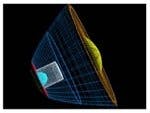University researchers reveal LED street-light design with precise beam and less glare
Beam control has been a key advantage of LED point sources in outdoor applications such as street lights where regulatory bodies define standards for the patterns applied to a roadway. Most solid-state lighting (SSL) street lights simply combine LEDs with total internal reflection (TIR) lenses to deliver a precise pattern, but researchers from the National Central University in Taiwan and the Autonomous University of Zacatecas in Mexico claim that adding a reflecting chamber and specialized diffuser lens can improve performance and lessen glare.
The research has been detailed in an academic paper published by the Optical Society on its Optics Express website. The paper entitled "High-performance LED street lighting using microlens array" concludes that the proposed design can limit the energy supplied to the street light that results in light pollution to 2% whereas the researchers say that in the best LED-based designs on the market today that 10% of the energy used is responsible for light pollution.
If you need some background of beam control and patterns, see the feature we published on the topic. The primary approach to beam control in LED-based products is via TIR lenses. In most products you can see the light emanating from the TIR lenses covering the individual LEDs. In contrast, street lights that use legacy HID lamps use a reflective box to attempt to control the pattern.
The proposed design still utilizes TIR lenses to collimate the light from the individual LED sources. But the LEDs are mounted in a reflecting chamber that can redirect or recycle rays of light that escape at wide angles since no lenses are perfect. Then the specialized diffuser that the team callas a microlens array includes both diffractive elements in the optic and also provides the uniformity properties that all diffusers offer. The research team says that the design can deliver a precise rectangular bean.
The published paper describes the optical analysis and simulation that the researchers have performed on the concept. Real-world validation will wait 3 to 6 months for the team to build prototypes.
Potential benefits await validation
The concept does hold some promise. Generally a diffuser would decrease optical efficiency. But the reflective chamber may compensate for any such optical loss combined with the fact that even fewer photons are misdirected relative the designs with no reflector and diffuser. The team calls the latter an increase in the optical utilization factor (OUF) and said that the proposed design would deliver OUF of 51-81% whereas as existing LED fixtures top out at 45%.
The biggest advantage of the design could be a reduction in glare because the diffusers hides the bright point sources and delivers more uniform light. Indeed we noted in a story last week on ourIndeed the research team said that today's LED street lights reduce power consumption by 40-60% relative to legacy sources, and that the proposed design could add 10-50% additional savings. Moreover, the team believes the design is cost effective because it "comprises just four parts, including a type of LED bulb commonly used in the lighting industry."






